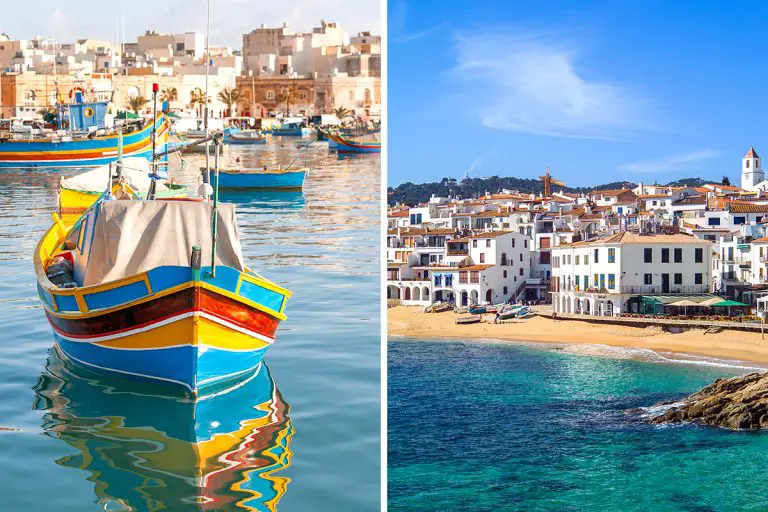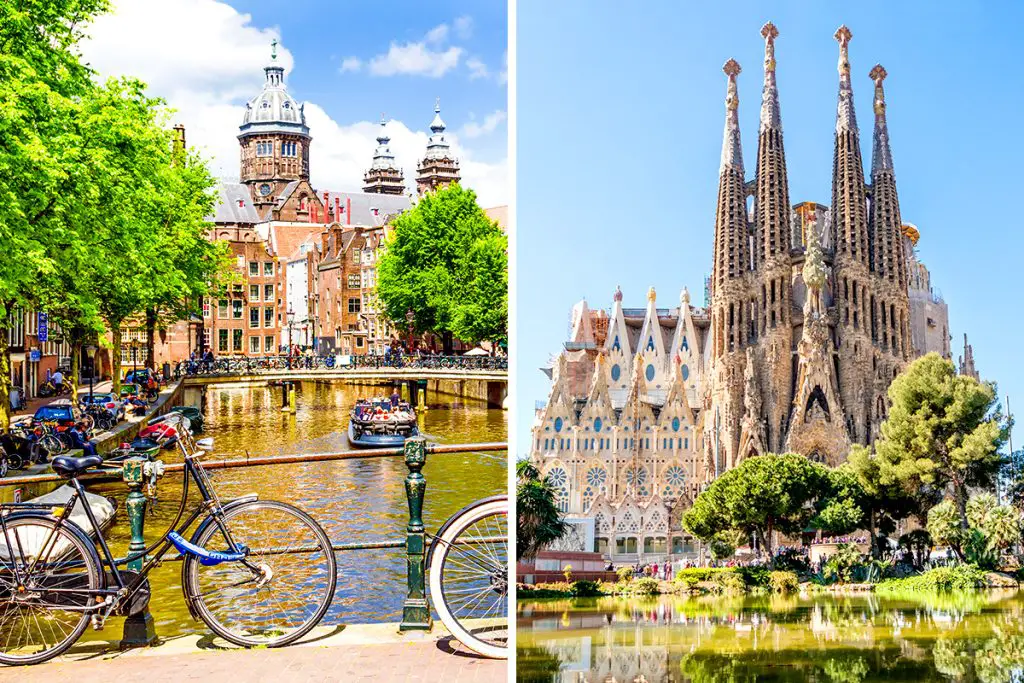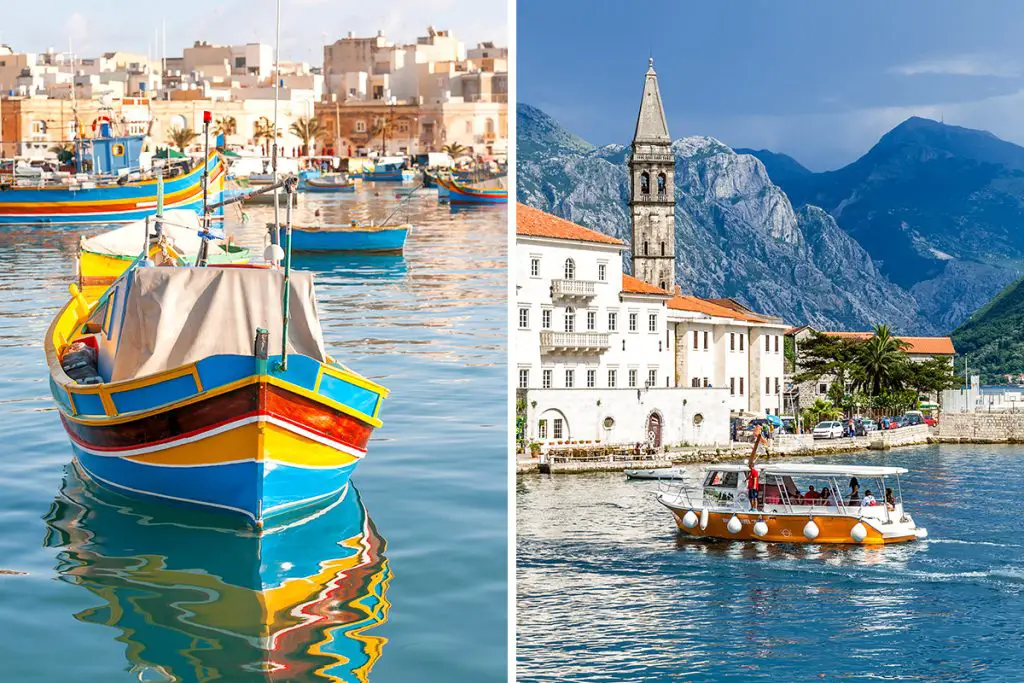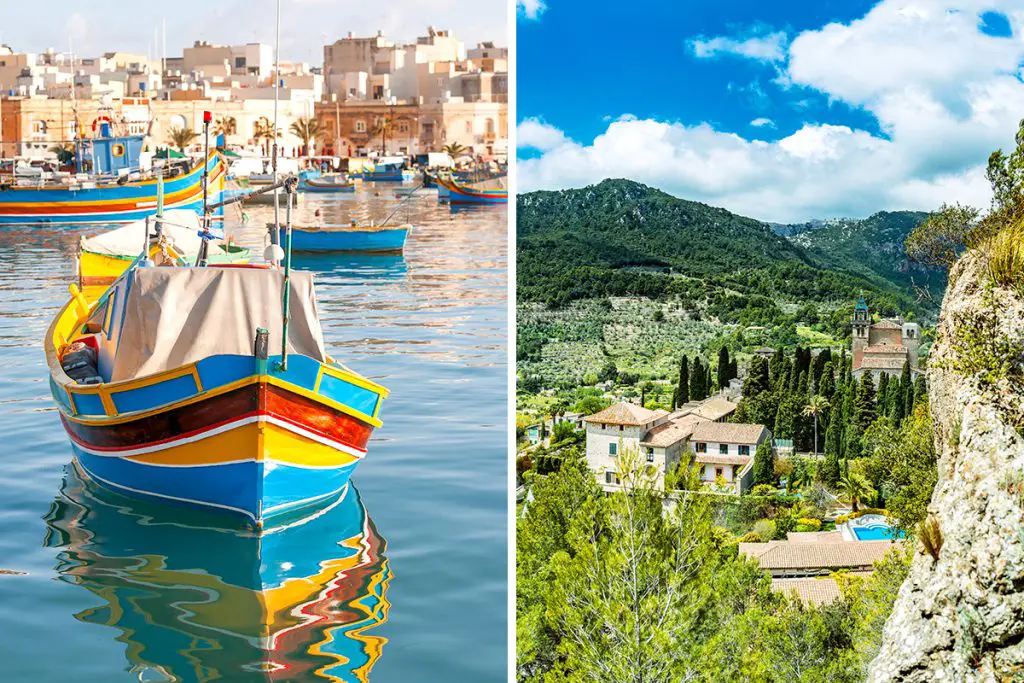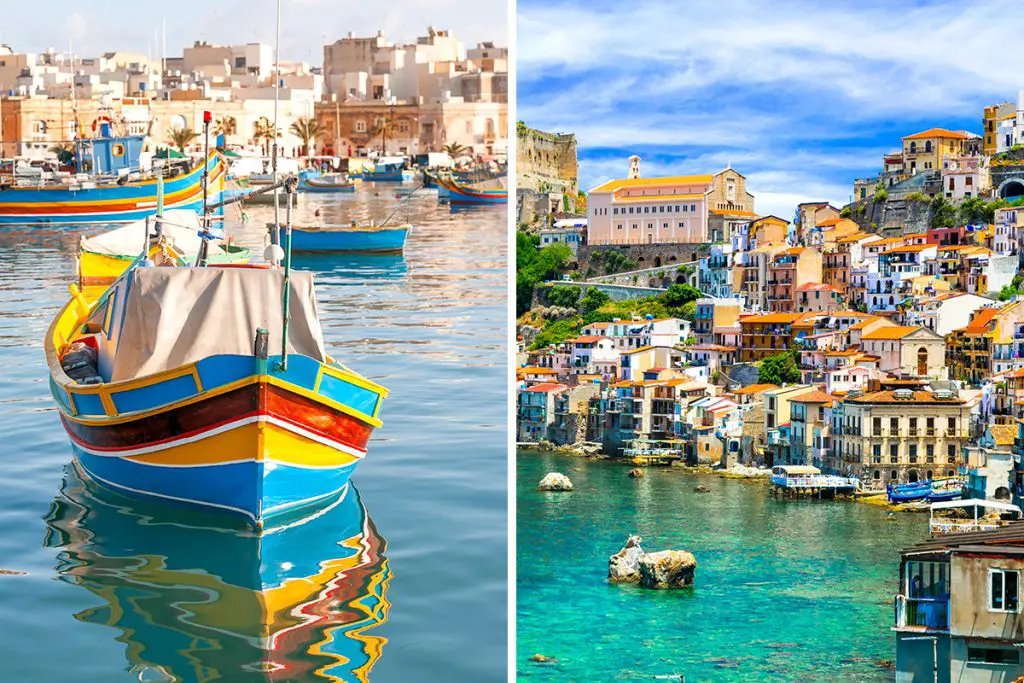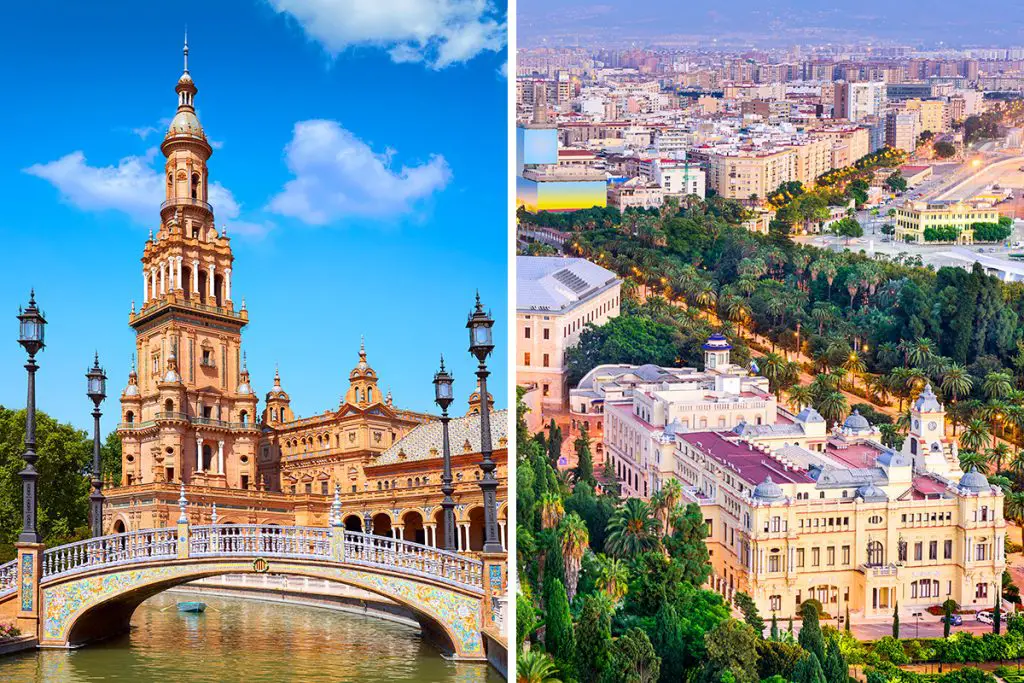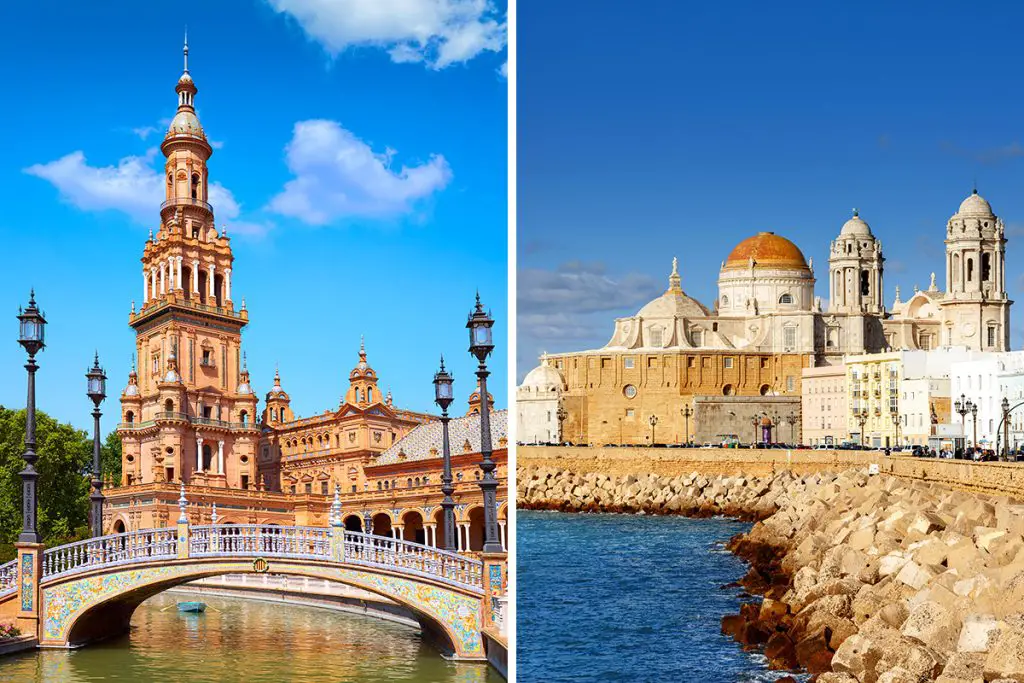Selecting the perfect vacation spot often comes down to what you’re looking to experience. Malta and Spain offer different slices of history and culture that can make choosing between them a challenging decision. From prehistoric temples in Malta to royal palaces in Spain, the options are seemingly endless.
Eager to unravel the tapestry of history and culture that each of these destinations offers? Stick around. You’re in for a fascinating comparison that just might help you make up your mind.
History & Culture
First off, let’s talk about what makes history and culture such rich and important pieces of any travel experience. They’re like the seasoning on a dish, giving each place its unique flavor. But how do Malta and Spain differ in these aspects?
Malta is a tiny island nation in the Mediterranean with a history that punches well above its weight. Think knights in shining armor and ancient temples.
Despite its small size of just around 316 square kilometers (122 mi), Malta’s history is a fascinating blend of influences from various civilizations like the Phoenicians, Romans, and Arabs. Over the years, this mix has cooked up a culture that is both distinct and intriguing.
Spain, on the other hand, spans a much larger area of about 505,990 square kilometers (195,363 sq. mi) and has a history filled with empires, conquests, and revolutions.
Flamenco dances and bullfighting are just the tip of the iceberg when it comes to Spain’s rich cultural heritage. Whether it’s the Moors in the South or the Celts in the North, Spain is a melting pot of cultures that have come together over centuries to form a unified yet diverse identity.
So, how do they compare? Malta offers an intimate, layered history where each invader left a distinct mark. It’s like reading a thrilling book where each chapter adds a new twist to the story. Spain gives you an expansive, sweeping view of history, with larger-than-life characters and events that have shaped not just the country but the world.
Attractions & Activities
Let’s switch gears and dive into what each destination offers in terms of attractions and activities. Sure, both Malta and Spain dazzle with their natural beauty and historical significance, but what can you actually do when you get there? Let’s find out.
In Malta, the “Hypogeum” is a must-visit if you’re keen on ancient history. This subterranean complex dates back more than 5,000 years and offers a glimpse into prehistoric life. Another iconic attraction is the medieval city of Mdina, also known as the “Silent City,” where narrow, winding streets reveal charming squares and sweeping views of the island.
For adventurous souls, scuba diving in Malta offers a unique experience. Dive into the Blue Hole in Gozo, a natural sea formation, and explore underwater caves and marine life.
Spain has no shortage of attractions either. Take the Alhambra in Granada, for instance. This palace and fortress complex is a jewel of Islamic architecture and offers a captivating experience as you walk through its intricate designs and lush gardens.
In Barcelona, the architectural genius of Antoni Gaudí is on full display at attractions like the Sagrada Familia and Parc Güell. And if you’re into art, the Prado Museum in Madrid houses one of the finest collections of European art, ranging from the 12th to the early 20th century.
Comparatively, Malta offers attractions that are more compact and easily accessible. You can visit multiple sites in a single day, given the country’s small size. Spain, however, requires more time to fully explore and appreciate its wide array of attractions spread across various cities.
Each destination has its own unique selling points: Malta offers intimate, unique experiences, while Spain delivers a broader range of monumental attractions.
To sum up, both Malta and Spain offer a variety of attractions and activities that can satisfy different tastes. While Malta is ideal for those who wish to delve deep into a smaller but layered historical canvas, Spain is perfect for those who seek a wide range of experiences and have more time to explore.
Beaches
Who doesn’t love a good beach? Both Malta and Spain offer stretches of sand and sea that can turn any vacation into a paradise. But how do they measure up? Let’s compare.
Malta is renowned for its rocky beaches, like Ghajn Tuffieha, a secluded spot that’s about 18 km (11.2 miles) from the capital city of Valletta. On the other hand, Mellieha Bay offers sandy shores and is approximately 24 km (14.9 miles) away from Valletta. These beaches are ideal for snorkeling and diving thanks to their clear, calm waters.
Spain is known for its diverse beach landscapes. La Concha in San Sebastián, roughly 468 km (291 miles) from Madrid, is often cited as one of the most beautiful urban beaches in Europe. If you’re looking for something more rugged, the beaches of the Costa Brava, about 103 km (64 miles) from Barcelona, offer craggy cliffs and secluded coves.
So, what’s the takeaway? Malta’s beaches are generally closer to the main cities, making them easier to access for a quick day trip. Spain’s beaches, while farther from the main cities, offer a broader range of experiences, from bustling urban beaches to secluded, natural spots.
In summary, your choice between Malta and Spain’s beaches will depend on what you’re looking for. If you prefer smaller, more accessible beaches with clear waters for snorkeling, Malta is the way to go. But if you’re up for a journey and wish to experience a variety of beach landscapes, Spain has you covered.
Eating, Drinking & Nightlife
When the sun sets, another aspect of travel comes alive: the culinary scene, the bars, and the nightlife. Both Malta and Spain offer a range of options that cater to every taste and lifestyle. Let’s see how they compare in these areas.
In Malta, you can enjoy a traditional meal of pastizzi, a flaky pastry filled with ricotta or peas, or perhaps some rabbit stew. Restaurants often serve these local dishes alongside Mediterranean cuisine, giving you a mix of flavors.
Spain counters this with an equally strong culinary tradition. Think paella in Valencia or tapas almost anywhere. From gazpacho to churros, every region in Spain offers something to tickle your taste buds.
For the drinks, Malta has its own set of local beverages. Kinnie, a type of non-alcoholic bittersweet drink, is very popular. On the alcoholic front, Maltese wines and beers are steadily gaining recognition. Spain, however, is a titan in the world of alcohol. It’s a land flowing with sangria, cava, and world-renowned wines from regions like La Rioja.
As for nightlife, Malta offers a more laid-back vibe with smaller clubs and pubs, primarily concentrated in areas like St. Julian’s. Spain turns the dial up with cities like Barcelona and Madrid, where the nightlife doesn’t just buzz—it roars. From flamenco shows to mega-clubs, Spain offers a vibrant nightlife that goes on till the early morning hours.
To sum it up, if you’re looking for a quaint, cozy eating and drinking experience coupled with a relaxed nightlife, Malta could be the destination for you. However, if you crave a wide array of culinary delights, a diverse drinking culture, and a high-energy nightlife, Spain is the clear choice.
Shopping
Shopping can be a highlight of any trip, and both Malta and Spain offer unique experiences. Whether you’re after souvenirs, fashion, or something a little different, let’s delve into what each destination has to offer.
In Malta, the local crafts are a big draw. You’ll find intricate lacework, handblown glass, and Maltese silver filigree jewelry in shops and markets. Ta’ Qali Crafts Village is a hotspot for these local goods.
Spain offers a different shopping vibe. From the luxury boutiques in Madrid’s Salamanca district to the quirky and artistic stores in Barcelona’s Gothic Quarter, the range is expansive.
Malta’s shopping scene is smaller and more focused on crafts and traditional items. It provides an intimate experience where you can often meet the artisans themselves. In Spain, shopping is a more cosmopolitan affair. Major cities offer not just local crafts but also high-end brands and cutting-edge fashion.
While Malta offers more of a traditional, nostalgic experience, Spain provides the rush of contemporary consumerism with a touch of tradition. Think handmade espadrilles from La Manual Alpargatera in Barcelona versus traditional Maltese clocks from Valletta.
In summary, Malta offers a shopping experience that’s rooted in craft and tradition, making it ideal for unique, handmade souvenirs. Spain, on the other hand, offers a wide array of shopping experiences, from high-end luxury to traditional crafts, satisfying both the modern and the traditional shopper.
Accommodation
One aspect of travel that often defines your overall experience is the accommodation. Both Malta and Spain offer a variety of places to stay, each with its unique style and amenities. Let’s dig in to see what you can expect.
Malta tends to offer more boutique hotels and private villas due to its smaller size. Many of these accommodations blend seamlessly into the historic and quaint atmosphere of the island. For example, you can stay in a traditional Maltese farmhouse in Gozo, fully decked out with limestone walls and archaic charm.
On the other hand, Spain offers a broader spectrum, from luxury high-rise hotels in cities like Madrid and Barcelona to quaint bed and breakfasts in the countryside.
In terms of variety, Spain stands out. Its array of accommodations reflects its diverse landscapes: you can find mountain lodges in the Pyrenees, beachside resorts along the Costa del Sol, and historic paradores (state-run hotels) in medieval castles and monasteries. Malta, while not as diverse, focuses on providing intimate settings, many with stunning views of the Mediterranean Sea.
Spain’s larger cities and popular tourist areas offer a multitude of hotel chains familiar to international travelers. Malta, in contrast, offers fewer chain hotels but makes up for it with more personalized services in family-run establishments.
In summary, Malta offers a more boutique experience, characterized by smaller, intimate accommodations, many of which have a local touch. Spain provides a wider variety, ranging from world-class luxury hotels to charming bed and breakfasts, suitable for all kinds of travelers.
Family-Friendliness & Children’s Activities
Traveling with family? Both Malta and Spain have got you covered. Whether it’s historical sites that double as educational experiences or just plain fun, each country offers a multitude of options to keep the kids entertained.
In Malta, the Popeye Village provides a fun-filled day where the family can explore the original film set of the 1980 Popeye movie. The island also offers several interactive museums and aquariums where learning is fun. Spain is not to be outdone in this regard. The CosmoCaixa in Barcelona offers interactive science exhibits that will keep kids engaged for hours.
The main difference lies in the types of activities each destination offers. Malta, with its more limited space, focuses on more contained, educational activities. Spain, on the other hand, offers large theme parks like PortAventura near Barcelona, which boasts an assortment of roller coasters and shows.
In terms of outdoor activities, Spain offers family-friendly hikes in regions like the Pyrenees and various water parks in the southern areas. Malta offers boat trips around its scenic islands, like Comino, where the whole family can snorkel in the Blue Lagoon.
In a nutshell, Malta offers a compact variety of family-friendly activities, often with an educational slant, that are easy to fit into a shorter holiday. Spain provides a broader range of options, including larger theme parks and outdoor adventures, making it ideal for longer family vacations.
Getting There & Getting Around
Transport is a crucial factor when planning your holiday. Whether it’s international travel or simply getting around once you’ve arrived, Malta and Spain each offer their own set of advantages and challenges.
To reach Malta, the primary gateway is Malta International Airport, located about 10 km (6.2 miles) from the capital city of Valletta. Spain has multiple international airports, including Madrid-Barajas and Barcelona-El Prat, among others. This makes Spain more accessible from a wider range of locations.
Once you’re in Malta, the island is compact enough for most destinations to be reachable within an hour’s drive. Public buses and ferries are often sufficient for most tourists. Spain, being a much larger country, has a well-developed train system, including high-speed trains like the AVE that can take you from Madrid to Barcelona in around three hours.
In terms of local travel, Spanish cities often have extensive metro systems, while Malta relies more on its bus network. Renting a car in Spain is a good idea if you plan to explore diverse regions, whereas in Malta, it’s often easier to rely on public transport due to the limited road network.
To sum it up, getting to and around Malta is generally quicker but might require more transfers if you’re coming from a location without a direct flight. Spain offers more direct international flight options and has a comprehensive internal transport network, making it easier to explore multiple regions.
Weather
When it comes to travel, the weather can make or break your experience. Malta and Spain both boast enviable climates, but they do differ in some key ways. Let’s break it down month by month to give you a clearer picture.
Malta generally enjoys a Mediterranean climate with hot, dry summers and mild, wet winters. From June to September, temperatures often soar to around 86-95°F (30-35°C).
Spain, on the other hand, offers a more varied climate due to its larger size and geographical features. Coastal areas like Barcelona can be similar to Malta in the summer, but central regions like Madrid can get much hotter, reaching up to 104°F (40°C).
Winter is more distinct between the two destinations. Malta rarely sees temperatures drop below 50°F (10°C), even in the coldest months of December and January. Spain experiences a wider range of winter temperatures, from mild along the coast to cold and snowy in northern regions like the Pyrenees, where it can drop to 32°F (0°C).
Spring and autumn are pleasant in both Malta and Spain. Malta sees temperatures ranging from 59-68°F (15-20°C) from March to May, and Spain has a similar range but can vary more depending on the region.
In summary, Malta offers a more stable, Mediterranean climate, ideal for beachgoers and those looking to escape colder temperatures. Spain provides more variety, with hotter summers and colder winters, catering to those who might want to mix a beach holiday with some winter sports.
Safety
Safety is often a top concern when choosing a travel destination. Both Malta and Spain have solid reputations, but there are differences worth noting.
In terms of crime rates, Malta is generally considered safe, especially in tourist-heavy areas. Spain also ranks high on the safety index but tends to have more instances of petty crime like pickpocketing, particularly in larger cities and crowded tourist spots.
When it comes to health care, both countries offer high standards. Malta has a strong public healthcare system, and Spain is known for its excellent hospitals and medical facilities. It’s advisable to have travel insurance for both destinations.
Unique to each country are natural hazards. Malta is largely free from natural disasters, but Spain is prone to forest fires during the hot summer months, particularly in the northern regions. It’s essential to stay updated on local news when traveling.
To sum up, both Malta and Spain are generally safe options for travelers. While both offer reliable healthcare, Spain has slightly higher rates of petty crime, and additional considerations around natural hazards exist.
Cost
Let’s talk about something everyone has in mind when planning a vacation: cost. Malta and Spain offer different experiences when it comes to how much you’ll spend.
A meal in a mid-range restaurant in Malta might cost you around €35, or roughly $37.10. In Spain, a similar meal could be a bit cheaper at about €22, especially if you’re outside major cities like Madrid or Barcelona, which would be approximately $23.32.
Accommodation varies as well. In Malta, a night in a three-star hotel generally averages around $110, whereas in Spain, prices average $175 for a similar category, depending on the region.
Transportation costs also differ. A bus ticket in Malta costs about €2, which is about $2.12, and in Spain, it ranges from €1.5 to €2 (approximately $1.59 to $2.12), again depending on the city. Taxis and rideshare services are widely available in both countries but are generally more expensive in Spain.
In summary, Malta tends to be a bit more expensive when it comes to dining and accommodation but is roughly on par with Spain for transportation costs. Your budget may go a bit further in Spain, especially if you venture outside of the tourist-heavy areas.
Which Is Better – Malta or Spain?
Deciding between Malta and Spain is no easy feat. Each offers its own unique blend of culture, activities, and amenities that cater to diverse travel desires. Here’s a rundown of how they stack up based on several critical factors to help you make your ultimate decision.
Firstly, in terms of history and culture, Malta boasts a rich tapestry of influences, from the Romans to the British. Spain, on the other hand, offers a variety of regional identities, each with their own unique traditions and history.
If you’re fascinated by the intertwining of various cultures through history, Malta may be your go-to. But if regional diversity tickles your fancy, Spain holds the cards.
When it comes to attractions and activities, Malta offers historical sites like the Megalithic Temples and the cities of Valletta and Mdina. Spain counters with a wider range of activities, from the art museums of Madrid to the architecture of Barcelona. If you’re an arts and history enthusiast, Spain has the edge.
Regarding beaches, Malta has compact but stunning options like Golden Bay, while Spain offers a vast coastline that varies from the Costa Brava to the Canary Islands. For a more intimate beach experience, Malta is your pick; for variety and endless sandy stretches, Spain takes the cake.
In the realm of eating, drinking, and nightlife, both countries boast strong culinary traditions and vibrant nightlife. However, Spain often provides a wider selection of tapas bars, restaurants, and nightclubs, especially in bigger cities.
As for accommodation, Malta offers a range of options but tends to be a bit pricier. Spain offers a more extensive variety of lodging possibilities, making it easier to find something that suits your needs. For budget-conscious travelers, Spain might offer more choices.
So, when should you choose Malta over Spain, or vice versa? If you’re after a destination with a compact but rich historical tapestry, smaller beaches, and a strong healthcare system, Malta is the choice for you. On the flip side, if you’re looking for a holiday full of variety in attractions, beaches, and nightlife, with a side of regional culture, Spain should be at the top of your list.

